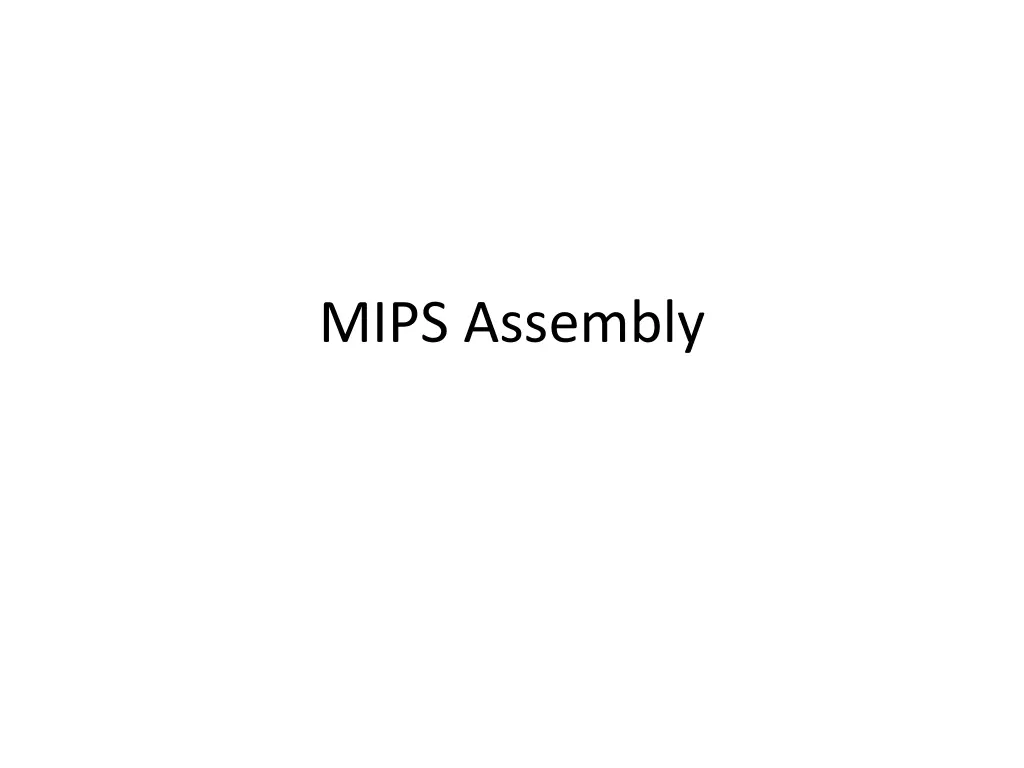
Understanding MIPS Assembly Language
Discover the significance of learning MIPS assembly language compared to higher-level languages like C. Explore the MIPS ISA, instruction sets, and arithmetic instructions, gaining insights into the future of processor architecture. Embrace the challenge of writing, reading, and debugging assembly code as it brings you closer to understanding the underlying processor operations.
Download Presentation

Please find below an Image/Link to download the presentation.
The content on the website is provided AS IS for your information and personal use only. It may not be sold, licensed, or shared on other websites without obtaining consent from the author. If you encounter any issues during the download, it is possible that the publisher has removed the file from their server.
You are allowed to download the files provided on this website for personal or commercial use, subject to the condition that they are used lawfully. All files are the property of their respective owners.
The content on the website is provided AS IS for your information and personal use only. It may not be sold, licensed, or shared on other websites without obtaining consent from the author.
E N D
Presentation Transcript
Why are we learning assembly Comparing to higher level languages such as C, assembly languages are more difficult to write, read, and debug. have poor portability Every processor has its own assembly language. The MIPS code you write is NOT going to run on Intel processors. Then why are we learning it? After learning the first assembly language, the second will be MUCH easier It brings us closer to the processor, which is the goal of this course.
MIPS ISA There are many different Instruction Set Architectures designed for different applications with different performance/cost tradeoff Including Intel-32, PowerPC, MIPS, ARM . We focus on MIPS architecture Microprocessor without Interlocked Pipeline Stages A RISC (reduced instruction set computer) architecture In contrast to CISC (complex instruction set computer) Similar to other architectures developed since the 1980's Almost 100 million MIPS processors manufactured in 2002 Used by NEC, Nintendo, Cisco, Silicon Graphics, Sony, 5/29/2025 CDA3100 3
A peek into the future 5/29/2025 CDA3100 4
Abstract View of MIPS Implementation 5/29/2025 CDA3100 5
MIPS Instruction Set An instruction is a command that hardware understands Instruction set is the vocabulary of commands understood by a given computer It includes arithmetic instructions, memory access instructions, logical operations, instructions for making decisions 5/29/2025 CDA3100 6
Arithmetic Instructions Each MIPS arithmetic instruction performs only one operation Each one must always have exactly three variables add a, b, c # a = b + c Note that these variables can be the same though If we have a more complex statement, we have to break it into pieces 5/29/2025 CDA3100 7
Arithmetic Instructions Example f = (g + h) (i + j) 5/29/2025 CDA3100 8
Arithmetic Instructions Example f = (g + h) (i + j) add t0, g, h # temporary variable t0 contains g + h add t1, i, j # temporary variable t1 contains i + j sub f, t0, t1 # f gets t0 t1 5/29/2025 CDA3100 9
Operands of Computer Hardware In C, we can define as many as variables as we need In MIPS, operands for arithmetic operations must be from registers MIPS has thirty-two 32-bit registers 5/29/2025 CDA3100 10
MIPS Registers 5/29/2025 CDA3100 11
Arithmetic Instructions Example f = (g + h) (i + j) #In MIPS, add can not access variables directly #because they are in memory # Suppose f, g, h, i, and j are in $s0, $s1, $s2, $s3, $s4 respectively add $t0, $s1, $s2# temporary variable t0 contains g + h add $t1, $s3, $s4# temporary variable t1 contains i + j sub $s0, $t0, $t1 # f gets t0 t1 5/29/2025 CDA3100 12
Memory Operands Since variables (they are data) are initially in memory, we need to have data transfer instructions Note a program (including data (variables)) is loaded from memory We also need to save the results to memory Also when we need more variables than the number of registers we have, we need to use memory to save the registers that are not used at the moment Data transfer instructions lw (load word) from memory to a register sw (store word) from register to memory 5/29/2025 CDA3100 13
Using Load and Store Memory address in load and store instructions is specified by a base register and offset This is called base addressing 5/29/2025 CDA3100 14
Using Load and Store How to implement the following statement using the MIPS assembly we have so far? Assuming the address of A is in $s3 and the variable h is in $s2 A[12] = h + A[8] 5/29/2025 CDA3100 15
Specifying Memory Address Memory is organized as an array of bytes (8 bits) 5/29/2025 CDA3100 16
Specifying Memory Address MIPS uses words (4 bytes) Each word must start at address that are multiples of 4 This is called alignment restriction Big Endian 5/29/2025 CDA3100 17
Example of Endianness Store 0x87654321 at address 0x0000, byte-addressable 5/29/2025 CDA3100 18
Example of Endianness Store 0x87654321 at address 0x0000, byte-addressable 5/29/2025 CDA3100 19
